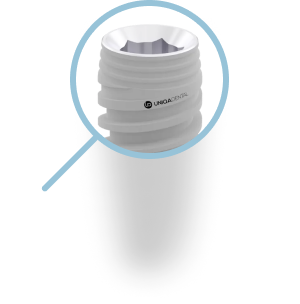Drilling procedure for UNIQA Dental Pure & Porous Implant UH8 UV11 [ 3.75 mm | D2-D3 bone density ]
Video description of the drilling protocol
IMPORTANT: Before inserting UNIQA Dental implants, you should familiarize yourself with the protocol for properly preparing the site in readiness for implant placement.
For example, the video shows the sequence of operations for inserting a 3.75 mm diameter implant into D2-D3 bone.
First, a hole must be made in the hardest cortical layer of the bone to a depth of 1 to 2 mm using a special drill for cortical bone.
Then, using a pilot drill with a diameter of 2 mm, make a hole to the full-depth, usually up to 10 mm. The recommended speed is 1000 rpm, maximum 1200 rpm. Do not forget intensive irrigation to cool the bevel and surrounding bone. Drill with moderate force so that you do not feel resistance to the bone.
Next, take a drill bit with a diameter of 2.5 mm and drill down to half of the depth of the future hole.
The next diameter drill to use is 2.8 mm. Drill down to a quarter of the depth of the future hole with this bit.
Next, using a 3.2 mm drill, expand the mouth of the hole to the depth of the cortical bone layer, which is usually 2 to 2.2 mm.
Replace the drill bit if you feel any resistance to the bone, as it is possible that the one you are working with is blunted.
Under no circumstances should you drill without water. Without intensive irrigation you can overheat the bone and cause thermal necrosis of the bone, which occurs after the placement of the implant.
Place the implant in the resulting hole. The aggressive thread profile of Uniqa Dental implants allows you to screw it directly into the bone tissue and ensure good primary stability.
Attention! Maximum allowable torque when inserting the implant is 50N*cm
IMPORTANT! Before installing UNIQA Dental implants, you should familiarize yourself with the protocol for preparing the implant site.
For example, the video shows the sequence of operations for installing a 3.75 mm diameter implant in D2-D3 bone density.
First, a hole must be made in the hardest cortical layer of the bone to a depth of 1 to 2 mm using a special drill for cortical bone.
Next, use a 2 mm diameter pilot drill to make a full-depth socket, typically up to 10 mm. The recommended rotation speed is 1000 rpm, maximum 1200 rpm. Do not forget about intensive irrigation to cool the bone and the drill. Drill with moderate force to avoid resistance from the bone.
Next, take a drill bit with a diameter of 2.5 mm and drill down to half of the depth of the future hole.
The next drill diameter is 2.8 mm, with which drill down to a quarter of the depth of the future hole.
Then, with a 3.2 mm drill, you need to expand the opening of the hole to the depth of the cortical bone layer, usually 2 to2.2 mm.
If you feel any resistance from the bone during the procedure, replace the drill, as the one you are using may have become dull.
Under no circumstances should you drill without water, as you can overheat the bone and cause thermal necrosis of the bone tissue, which will manifest itself after the implant is installed.
Install the implant in the resulting hole. The aggressive thread profile of Uniqa Dental implants allows it to be screwed directly into the bone tissue and provide good primary stability.
Attention! The maximum allowable torque when installing the implant is 50 N*cm.



![Drilling procedure for UNIQA Dental Pure & Porous Implant UH8 UV11 [ 3.3 mm | D1 bone density ]](https://img.youtube.com/vi/lNch2ns-gAI/maxresdefault.jpg)




